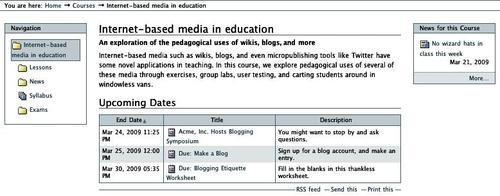Now that we have a full-featured container, let's add an example course.

A simple folder is the root of our course:
1. Add a folder within the Courses folder. Set its title to the name of our example course, "Internet-based media in education."
Several folders within provide spots for other content:
2. Create a Lessons folder within your course. Set its Display to Summary view to hide distracting authorship information and modification dates.
3. Head back to the "Internet-based media in education" folder that represents your course, and make an Exams folder. The "Exams" categorization won't necessarily make sense for every course, but it is an example of where to put calendar events unassociated with any specific lesson.
4. Ascend back to the "Internet-based media in education" folder, and make a News folder, a home for announcements that should not appear on the site's calendars and other by-date listings.
Now that we have a skeleton of a course, we can flesh out the component folders with example content.



